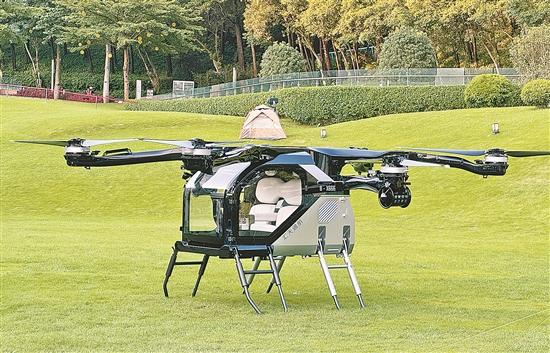
In recent days, two major developments have taken place in Guangdong's low-altitude economy. On the product side, Guangzhou-based XPENG AERAOHT debuted the world's only new "species" of flying vehicles, representing a breakthrough in the field. On the application side, at the first Guangdong-Hong Kong-Macao Greater Bay Area Low-Altitude Economy Seminar (Guangzhou), experts explored futuristic applications for low-altitude technologies.

This product debut offers a glimpse into the future of aerial vehicles while the futuristic visions set a direction for its development. The convergence of these efforts is expected to further accelerate the growth of Guangdong's low-altitude economy.
In recent years, the low-altitude economy, as a key player in emerging strategic industries, is gaining momentum, meeting the growing public demand for convenient lifestyles. Guangdong, China's top economic province, has been positioning itself in this sector for some time. The province has included low-altitude economy initiatives in its government work reports and launched the "Action Plan for High-Quality Development of the Low-Altitude Economy in Guangdong Province (2024-2026)," with a goal of exceeding 300 billion yuan in economic output by 2026. Several cities including Guangzhou, Shenzhen, Zhuhai, and Huizhou have also introduced city-level policies to support the development of this sector.
On the corporate side, industry leaders like EHang and XAG in Guangdong are driving innovation across the entire supply chain, contributing to remarkable achievements. EHang, for example, is the world's only manufacturer of unmanned aerial vehicles with three key certifications (type certificate, airworthiness certificate, and production certificate). XAG, an agricultural drone company based in Guangzhou, made waves at the Agritechnica (the world's largest trade fair for agricultural machinery and equipment) in May, partnering with Thailand's CP Group to further promote automated farming equipment in Thailand.
However, as the low-altitude economy transitions from rapid growth to high-quality development, it faces challenges such as complex airspace management and insufficient safety and intelligence in handling dynamic environments. Looking ahead, industry experts are sharing insights on how to push the sector forward toward sustainable and high-quality development.
Xing Hanfa, Vice President of the Guangdong Innovation Science Research Institute, Executive Dean of the Beidou Research Institute at South China Normal University, and Chief Technical Advisor for Guangzhou Chenxing Future Aviation Technology, emphasized the role of spatiotemporal information in empowering the low-altitude economy. He suggested transforming the low-altitude airspace into a measurable, manageable, and usable spatiotemporal data environment. He also highlighted the importance of building a new type of infrastructure to support this, ensuring safe, intelligent, and efficient flight operations. Xing argued that an integrated approach to communication, navigation, and remote sensing will be key to ensuring safety, while advancements in spatiotemporal intelligence will enhance smart decision-making, therefore driving the sector toward high-quality growth.
Professor Cheng Chengqi, a member of the National Air Traffic Management Advisory Committee (NATMAC) and Director of the Aerospace Information Engineering Research Center at Peking University, called for the creation of a unified national spatiotemporal standard for low-altitude operations, as well as the establishment of a three-dimensional traffic signal system to regulate low-altitude transportation. These efforts would further support the development of the necessary infrastructure for low-altitude air traffic management.
Source : Lingnan on the Cloud
新物种亮相,广东低空经济蓄势提速腾飞
近几天,广东低空经济领域又有两件大事发生:在产品端,广州低空经济领域的代表性企业小鹏汇天首秀了全球唯一的新“物种”;在应用端,首届粤港澳大湾区低空经济研讨会(广州)对低空经济的应用场景进行了科学畅想。
硬核产品首秀,或让我们提前窥见了未来飞行器的发展方向;应用场景畅想,则为产品研发指明了发展方向。两相结合,广东低空经济发展,有望迎来再次提速发展。
近年来,作为战略性新兴产业的重要赛道,低空经济正“加速起飞”,满足人民对便捷生活的更多期待。作为“经济第一大省”,广东在低空经济的抢滩布局也早已开始。目前,广东已将低空经济相关内容写入政府工作报告,印发实施《广东省推动低空经济高质量发展行动方案(2024—2026年)》,并提出到2026年,广东低空经济规模将超过3000亿元。广州、深圳、珠海、惠州等地市也已印发出台市级层面支持低空经济发展政策。
而在企业端,广东的亿航智能、极飞科技等一众龙头企业也带动着上下游产业链创下一个又一个“广东成就”:亿航智能是全球唯一拥有“三证合一”(即型号合格证、适航证、生产许可证)的无人驾驶航空器制造商;长期在广州耕耘的农业植保无人机制造商极飞科技,也在今年5月与泰国正大集团联手亮相汉诺威农机展,进一步推动农业无人化设备在泰国的应用与普及……
不过,目前低空经济产业正在从高速增长转向高质量发展,面临着用空管理难、复杂环境安全性与智能化水平不足等挑战。未来,低空经济如何进一步实现高质量发展?企业和业内专家纷纷给出了自己的看法,助力低空经济提速腾飞。
广东创新科学研究院副院长、华南师范大学北斗研究院执行院长、广州辰星未来航空科技首席技术顾问邢汉发提出时空信息赋能低空经济这一观点,将低空空域变成可定标、可量化、可计算、可管理、可利用的时空数据空间,并认为发展时空数字底座这一新型基础设施可以保障低空经济“飞得起来”,发展通导遥一体化可以确保低空经济“飞得放心”,发展时空智能技术,在智能决策支持下可以助力低空经济“飞得聪明”,从而全面助力低空经济实现高质量发展。
国家空管委专家咨询委委员、北京大学空天信息工程研究中心主任程承旗教授认为,应创建全国统一的低空时空标准、推动低空立体交通红绿灯系统建设、推动低空立体交通红绿灯基础设施应用。
文、图 |羊城晚报记者 李志文
译|赵凡
审|林佳岱
-
Poster丨The first Foshan Nanfeng Lantern Show of the Mid-Autumn Festival will open soon
2024-09-11 21:38:29 -
Fu Chao, chief scientist at Songshan Lake Materials Laboratory: advancing industry with scientific innovations
2024-09-11 22:39:59 -
Huawei launches Mate XT, world's first tri-fold smartphone with over 4.3 million pre-orders
2024-09-11 22:40:04 -
Poster丨Guangzhou BaoMo Garden: Koi fish mermaids will perform synchronized swimming at Mid-Autumn Festival
2024-09-10 21:01:48






